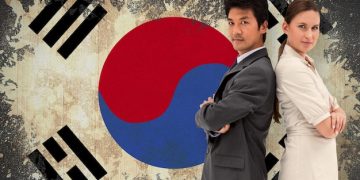Korean Drama Remakes: The Best and Worst US Adaptations

Advertisements
Korean drama remakes in the US have seen varying degrees of success. Some adaptations capture the essence of the original while others miss the mark, sparking debate among fans.
The world of television is no stranger to remakes, and Korean dramas, or K-dramas, have become a popular source material for US adaptations. But which of these remakes truly capture the magic of the original, and which fall flat? Let’s delve into the landscape of Korean Drama Remakes: Which US Adaptations Are Worth Watching and Which Miss the Mark?
Anúncios
The Allure of K-Dramas and Their Remake Potential
Korean dramas have gained immense popularity worldwide, thanks to their compelling storylines, high production values, and talented actors. This widespread appeal has made them attractive prospects for remake adaptations in other countries, particularly in the United States.
The unique blend of genres, often combining romance, comedy, drama, and suspense, provides a rich tapestry for storytelling that resonates with diverse audiences. Furthermore, the tight, often one-season structure of many K-dramas allows for concise and focused narratives, which can be appealing for adaptation.
Anúncios
Why Remake K-Dramas?
Remaking K-dramas presents several potential benefits. It allows for the introduction of beloved stories to a new audience base that might not otherwise be exposed to the original. Adaptations can also offer a fresh perspective on familiar narratives, tailoring them to suit different cultural contexts and tastes.
Challenges in Adapting K-Dramas
However, the process of adapting a K-drama for US television is not without its challenges. Maintaining the original’s essence while making necessary changes for a new audience requires a delicate balance. Cultural nuances, character portrayals, and pacing can all pose significant hurdles.
- Cultural Differences: Adapting cultural nuances for a US audience is crucial to avoid misrepresentation or misunderstanding.
- Character Development: The development and portrayal of characters need careful consideration to ensure they resonate with viewers.
- Pacing and Tone: Adjusting the pacing and tone to suit US television expectations can be critical for success.
- Maintaining Authenticity: Striking a balance between adaptation and preserving the core elements of the original is essential.
Successfully navigating these challenges can lead to a remake that pleases both fans of the original and new viewers. Conversely, failing to address these challenges can result in a poorly received adaptation that misses the mark.
Navigating the Success Spectrum: Hits and Misses
The world of K-drama remakes in the US is a mixed bag, with some adaptations achieving critical acclaim and commercial success, while others are met with lukewarm reception or outright criticism. Understanding what makes a remake successful involves examining the factors that contribute to its triumph or failure.
Successful adaptations often stay true to the spirit of the original while making smart, well-considered changes to suit the new cultural landscape. These changes might involve updating the setting, adjusting character backstories, or modifying plot elements to better resonate with US audiences.
Factors Contributing to Successful Remakes
Several factors can contribute to the success of a K-drama remake. Strong writing, compelling performances, and thoughtful adaptation of cultural elements are key ingredients. Additionally, effective marketing and promotion can help generate interest and draw in viewers.
- Strong Writing: A well-written script that captures the essence of the original is crucial.
- Compelling Performances: Talented actors who can bring the characters to life are essential.
- Thoughtful Adaptation: Adapting cultural elements in a way that respects the original while resonating with a new audience.
- Effective Marketing: Generating interest and attracting viewers through strategic marketing and promotion.
Conversely, unsuccessful remakes often suffer from a lack of understanding of the original material, poor casting choices, or misguided attempts to alter the story in ways that undermine its core themes. These missteps can lead to a product that disappoints both fans of the original and new viewers.
Ultimately, the success of a K-drama remake hinges on the ability to capture the magic of the original while making it relevant and accessible to a new audience. Remakes that strike this balance are more likely to be considered worthwhile adaptations.
“Good Doctor”: A Resounding Success Story
One of the most notable success stories in the realm of K-drama remakes is “Good Doctor.” The American adaptation, which aired on ABC, garnered widespread acclaim for its faithful yet nuanced portrayal of the original Korean series. The show’s focus on a young autistic surgeon navigating the challenges of his profession resonated deeply with audiences.
The US version of “Good Doctor” managed to capture the heart of the original while tailoring it to suit American sensibilities. Key themes such as acceptance, empathy, and overcoming adversity were retained, contributing to the show’s broad appeal.
Key Strengths of the US “Good Doctor” Adaptation
Several factors contributed to the success of the US “Good Doctor” adaptation. The casting of Freddie Highmore in the lead role was widely praised, as he delivered a compelling and nuanced performance that captured the complexities of the character. The writing team also deserve credit for crafting storylines that were both engaging and sensitive.
- Excellent Casting: Freddie Highmore’s portrayal of Dr. Shaun Murphy was a major highlight.
- Sensitive Storylines: The show sensitively addressed themes of acceptance and overcoming adversity.
- Strong Character Development: The characters were well-developed and relatable.
- High Production Values: High-quality production values further enhanced the show’s appeal.
Moreover, the show tackled important social issues with nuance and care, further enhancing its appeal. By staying true to the core message of the original while adapting the story for a new audience, “Good Doctor” proved to be a resounding success.
The success of “Good Doctor” serves as a blueprint for other K-drama remakes, demonstrating that with careful planning, respect for the original material, and talented execution, it is possible to create an adaptation that honors the source material while standing on its own merits.
When Adaptations Fall Short: Missed Opportunities
While some K-drama remakes have achieved significant success, others have failed to capture the essence of the original or resonate with audiences. These missed opportunities serve as cautionary tales, highlighting the pitfalls of adapting beloved stories without due care and attention.
One common reason for the failure of a remake is a lack of understanding of the original material. This can lead to misguided changes that undermine the story’s core themes or misrepresent its characters. Poor casting choices, weak writing, and a failure to adapt cultural nuances can also contribute to a remake’s downfall.
Common Pitfalls in K-Drama Remakes
Several pitfalls can derail a K-drama remake. Rushing the adaptation process, failing to cast actors who can embody the characters convincingly, and making unnecessary changes to the plot can all have negative consequences.

Avoiding these pitfalls requires a deep understanding of the source material, careful planning, and a willingness to prioritize quality over speed. Remakes that are produced with these considerations in mind are more likely to resonate with viewers and avoid the fate of becoming a missed opportunity.
Ultimately, неудачные remakes serve as a reminder that adapting a K-drama for US television is not simply a matter of translating the story into a new language. It requires a deep appreciation for the original material, a keen understanding of cultural differences, and a commitment to creating a high-quality product.
The Importance of Cultural Sensitivity in Adaptations
One of the most crucial aspects of adapting a K-drama for a US audience is cultural sensitivity. Korean dramas often contain uniquely Korean cultural elements that may not translate directly to a Western audience without careful consideration.
Ignoring these cultural nuances can lead to misrepresentation or misunderstandings, which can alienate both fans of the original series and new viewers. Successful adaptations take the time to understand and respectfully adapt these elements for a new cultural context.
Examples of Cultural Elements to Consider
Cultural elements to consider during adaptation include family dynamics, societal expectations, and communication styles. These elements can significantly impact the storytelling and character development, so it’s important to handle them with sensitivity.
- Family Dynamics: Korean dramas often place a strong emphasis on family relationships and filial piety.
- Societal Expectations: Understanding societal expectations and norms in Korea is crucial.
- Communication Styles: Adapting communication styles to suit a Western audience while preserving the original’s intent.
- Respect for Traditions: Showing respect for Korean traditions and customs.
Adapting these elements requires more than just translating dialogue; it requires understanding the underlying cultural context and finding ways to convey that context to a new audience. This could involve adding explanatory scenes, tweaking character interactions, or adjusting the overall tone of the story.
Ultimately, cultural sensitivity is not just about avoiding offense; it’s about creating a richer, more meaningful adaptation that resonates with viewers on a deeper level. By taking the time to understand and respect the cultural nuances of the original K-drama, remakes can avoid pitfalls and create adaptations that are both faithful and engaging.
Future Trends in K-Drama Remakes
The trend of remaking K-dramas for US television is likely to continue, driven by the increasing popularity of Korean content and the desire to bring these stories to a wider audience. As more remakes are produced, it’s important to consider what future trends might emerge in this space.
One potential trend is a greater focus on collaboration between Korean and American production companies. This could lead to more authentic and culturally sensitive adaptations, as Korean creators would have a direct hand in shaping the remakes.
Possible Future Trends in K-Drama Remakes
Looking ahead, several trends could shape the future of K-drama remakes. Increased collaboration, diverse casting, and genre exploration are all possibilities to consider.
- Increased Collaboration: More collaboration between Korean and American production companies.
- Diverse Casting: Featuring more diverse casts to reflect the changing demographics of US audiences.
Another trend could be a shift towards remaking a wider range of K-dramas. While many of the current remakes focus on romantic comedies or medical dramas, future adaptations might explore genres such as thrillers, historical dramas, or science fiction.
Regardless of the specific trends that emerge, the key to successful K-drama remakes will continue to be a commitment to quality, cultural sensitivity, and a deep understanding of the original material. Remakes that prioritize these factors are more likely to resonate with viewers and contribute to the continued popularity of both Korean dramas and their adaptations.
| Key Aspect | Brief Description |
|---|---|
| 🌟 Success Factors | Strong writing, casting, and cultural adaptation are key to remake success. |
| 🎭 “Good Doctor” | The US adaptation was praised for its faithful yet nuanced portrayal. |
| ⚠️ Common Pitfalls | Lack of understanding and poor casting can lead to remake failures. |
| 🌍 Cultural Sensitivity | Respecting cultural nuances is crucial for authentic adaptations. |
Frequently Asked Questions
A successful K-drama remake balances faithfulness to the original with adaptations suited for a new audience, maintaining cultural sensitivity and high production quality.
The US version of “Good Doctor” is widely regarded as the most successful K-drama remake, earning critical acclaim and commercial success.
Common mistakes include a lack of understanding of the original material, poor casting of actors, and insensitive adaptation of cultural nuances.
Cultural sensitivity ensures the adaptation respects the original’s intent and avoids misrepresentation, leading to a more authentic and relatable viewing experience.
Future trends may include increased collaboration between Korean and American companies, diverse casting, and expansion into various genres from romantic comedies to thrillers.
Conclusion
Ultimately, the world of Korean drama remakes is a complex landscape of hits and misses. While some adaptations, like “Good Doctor,” have proven the potential for success, others serve as cautionary tales of the challenges involved in bringing these beloved stories to a new audience. Moving forward, a commitment to cultural sensitivity, strong writing, and talented casting will be essential for creating remakes that honor the original material while resonating with viewers in the US.





